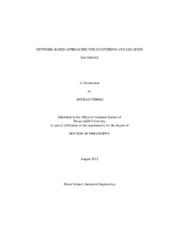| dc.description.abstract | The objective of this dissertation is to study commonly occurring location and clustering problems on graphs. The dissertation is presented as a collection of results in topics including finding maximum cliques in large graphs, graph clustering in large scale graphs, determining location of facilities for pre-positioning emergency relief supplies, and selecting nodes to form a virtual backbone in a wireless sensor network.
To begin with, a new clique relaxation called a k-community is defined as a connected subgraph such that endpoints of every edge have at least k common neighbors within the subgraph. It is used to develop scale reduction techniques to obtain the maximum clique on very large scale real life networks. Analytically, the technique is been shown to be very effective on power-law random graphs. Experimental results on real life graph instances (Collaboration networks, P2P networks, Social networks, etc.) show our procedure to be much more effective than a regular k-core peeling approach.
Next, a general purpose network clustering algorithm based on the clique relaxation concept of k-community is presented. A salient feature of this approach is that it does not use any prior information about the structure of the network. By defining a cluster as a k-community, the proposed algorithm aims to provide a clustering of a network into k-communities with varying values of k. Even though the algorithm is not designed to optimize any particular performance measure, the computational results suggest that it performs well on a number of criteria that are used in literature to evaluate the quality of a clustering.
The third topic deals with choosing the locations of disaster response facilities for the storage of emergency supplies, which is critical to the quality of service provided in a large scale emergency like an earthquake. In the existing literature, large scale emergency facility location models have either assumed that disaster response facilities will always be functioning and available when required, or that the functioning of a facility is independent of a particular disaster scenario. In this paper new location models are presented that explicitly take into consideration the stochastic nature of the impact a disaster can have on the disaster response facilities and the population centers in surrounding areas. A comparison of the results obtained using our models with those from models available in literature using a case study suggests that the locations suggested by the model in this paper significantly reduce the expected cost of transportation of supplies when we consider the damage a disaster causes to the disaster response facilities and areas near it.
Lastly, a distributed approximate algorithm for forming the communication backbone in wireless sensor networks is presented. Some of the most popular routing protocols for wireless sensor networks require a virtual backbone for efficient communication be- tween the sensors. Connected Dominating Sets (CDS) have been studied as a method of choosing nodes to be in the backbone. The traditional approach is to assume that the transmission range of each node is given and then minimize the number of nodes in the CDS representing the backbone. A recently introduced alternative strategy is based on the concept of k-bottleneck connected dominating set (k-BCDS), which, given a positive integer k, minimizes the transmission range of the nodes that ensures a CDS of size k exists in the network. This paper provides a 6-approximate distributed algorithm for the k-BCDS problem. The results of empirical evaluation of the proposed algorithm are also included. | en |


